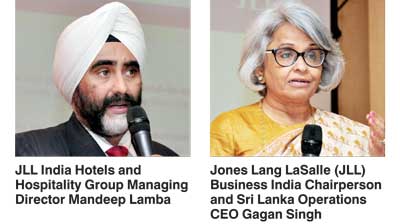Monday Apr 07, 2025
Monday Apr 07, 2025
Thursday, 14 January 2016 00:00 - - {{hitsCtrl.values.hits}}
By Uditha Jayasinghe
As the flow of tourists ebbs, removing the long-established minimum room rate for Colombo hotels could benefit the industry by increasing competitiveness, experts said yesterday, creating room for stronger price adjustments with similar international markets.
While Colombo has a strong and diverse demand base, future growth will be linked largely to the level of corporate growth and foreign investment as well as the successful marketing and development of Colombo as a leisure destination, noted Jones Lang LaSalle (JLL) Business India Chairperson and Sri Lanka Operations CEO Gagan Singh unveiling the latest review of the Sri Lankan hospitality industry. The report, titled ‘Charting an Upward Momentum,’ was rosy about Sri Lanka’s arrival numbers, which have grown over 17% in 2015.
The industry also enjoyed a 74.3% occupancy rate that is significantly ahead of regional destinations such as India. However, Colombo’s occupancy rates dropped to 57% from 64% notched up in 2012/13, according to analysed data.
Colombo’s current number of 4,500 rooms is expected to double to 8,500 rooms by 2020. This growth is 65% of the planned 8,000 keys for the whole country over the next few years. Although entry of many large-scale projects such as Shangri-la, ITC and Sheraton have been delayed, they are likely to enter the market within the next five years resulting in additional pressure on hotel performance, with hotel supply likely to outpace room night demand in the short term, the report observed.
“When the minimum room rate was introduced it was a positive step but today we feel rolling it back would benefit the market. There is a sense charges are higher in Sri Lanka for the product currently on offer at certain times of the year, especially when compared with rival destinations such as Myanmar, Vietnam and Philippines. Sri Lanka would benefit from letting the market decide rates,” said JLL India Hotels and Hospitality Group Managing Director Mandeep Lamba.
Lamba called on the industry to better understand their prospective clients and work harder to meet their expectations as a way of attracting well-paying tourists. Finding new niches or expanding on existing ones like tea and religious tourism was advocated by the experts. 
Future growth in the capital will be largely linked to the level of corporate growth and foreign investment, despite the latter’s contribution to commercial activity and industry have been lower than anticipated. New attractions and developments in the city including conference and event based tourism, are likely to drive future demand. Specific measures to promote Colombo as a MICE and entertainment destination are likely to see benefits in the long term.
Colombo’s tourism fortunes are also dependent on the latest Budget, which aims to widen doors for foreign investment. The planned megapolis venture is also crucial as it will decide the ease of movement, air quality and attractions available to tourists.
Turning to the lucrative south-western coastline of Sri Lanka the study notes this year the market is likely to see the entry of more internationally branded hotels on a large scale, beginning with the South-west coast, followed by Colombo and eventually other parts of the country, which is expected to boost average room rates in line with the new hotels product offering and the changing supply composition.
Such an influx of about 2,000 rooms, mostly on the high-end scale, is likely to boost the entire region but the market will also become extremely competitive as the new international brands will drive their own demand with strong distribution channels and fresh products. The introduction of high inventory hotel development is expected to revive chartered tourist arrivals with agreements already signed.
“Overall Sri Lanka will still have to concentrate on infrastructure as connectivity to some regions remains difficult. This is most important for the north and east regions. The Government also has to carefully structure its key regulations and surrounding foreign investment and ownership to keep a stable policy environment,” observed Lamba.
International flights to Sri Lanka remain expensive when compared with similar destinations and it is necessary to increase carriers from large source markets of Sri Lanka. Destination marketing will also be critical to increase the variety and numbers of tourists to Sri Lanka. Improving human resources is another essential area for the industry with shortages already being felt and likely to impact the quality of the product on sale if left unaddressed, the report pointed out.